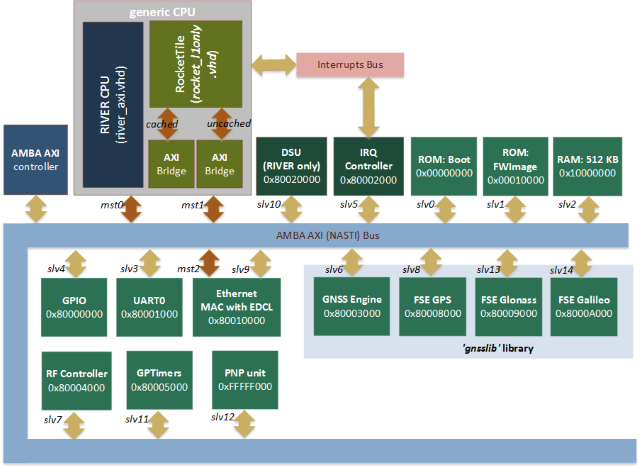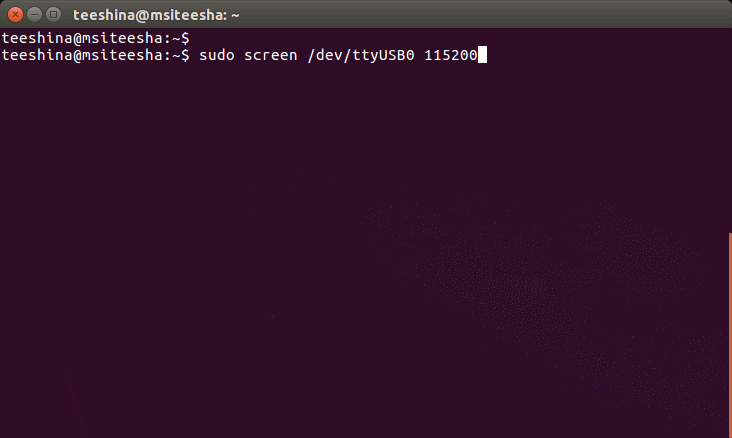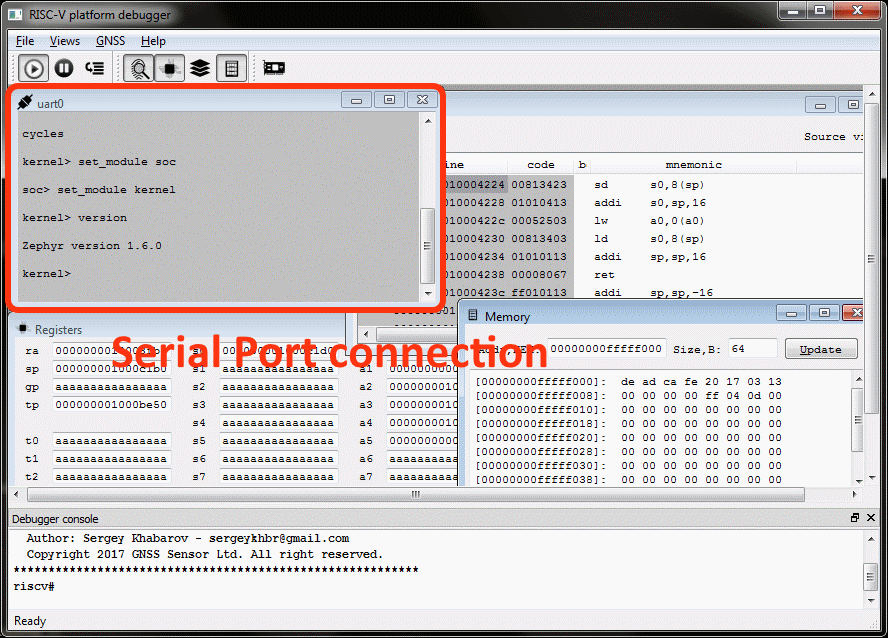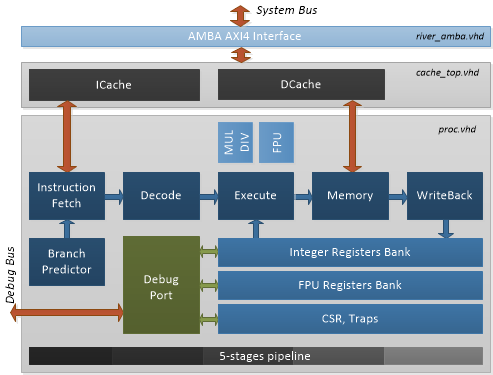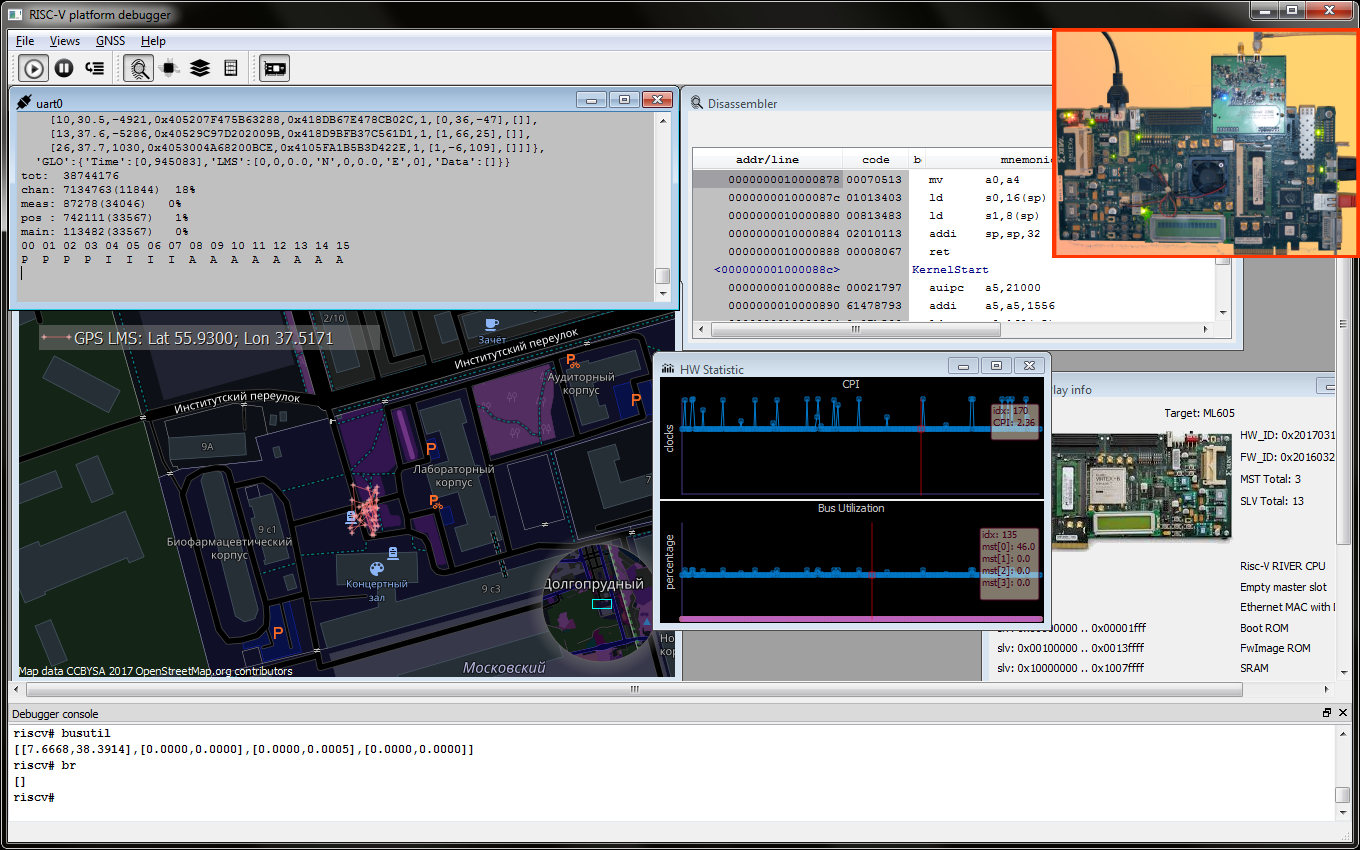This repository provides open source System-on-Chip implementation based on 64-bits CPU "Rocket-chip" distributed under BSD license. SOC source files either include general set of peripheries, FPGA CADs projects files, own implementation of the Windows/Linux debugger and several examples that help to run your firmware on almost any FPGA boards. Satellite Navigation (GPS/GLONASS/Galileo) modules were stubbed in this repository and can be requested separately.
What is Rocket-chip and RISC-V ISA?
RISC-V (pronounced "risk-five") is a new instruction set architecture (ISA) that was originally designed to support computer architecture research and education and is now set become a standard open architecture for industry implementations under the governance of the RISC-V Foundation. RISC-V was originally developed in the Computer Science Division of the EECS Department at the University of California, Berkeley.
Parameterized generator of the Rocket-chip can be found here: https://github.com/ucb-bar
It's my own implementation of RISC-V ISA used in a several projects including
the multi-sytem Satellite Navigation receiver. It is great for an
embedded applications with active usage of 64-bits computations (like DSP).
River CPU includes the following tools and features:
- Source code
- /debugger/cpu_fnc_plugin - Functional RISC-V CPU model.
- /debugger/cpu_sysc_plugin - Precise SystemC RIVER CPU model.
- /rtl/riverlib - synthesisable VHDL model of a 64-bit processor compliant with the RISC-V architecture.
- Floating Point Unit (FPU)
- Dual-Core configuration
- Advanced debugging features
- Test Access Points (TAPs) via Ethernet, UART and JTAG in one system.
- System Bus tracer
- Pipeline statistic (CPI, HW stacktrace) in a real-time on HW level.
- Plug'n'Play information
- Integration with GUI from the very beginning.
You can find several demonstration videos here of working with the Dual-Core SoC on FPGA and with the emulated platforms.
My goal is to develop open source fault-tolerant processor with the user-friendly framework.
SoC documentation in .pdf formats.
Performance analysis is based on very compact Dhrystone v2.1. benchmark application available as the bare-metal test in $(TOP)/example/dhrystone21 folder and entirely ported into Zephyr shell (see animated gif below). Benchmark was executed with enabled (-O0) and disabled (-O2) optimization to define HW and GCC-compiler advantages. All sources are available and could be run on the simulator or on the different FPGA targets.
| Target | Git tag | Dhrystone per sec, -O0, 60 MHz |
Dhrystone per sec, -O2, 60 MHz |
Information. |
|---|---|---|---|---|
| RISC-V simulator | latest | 76824.0 | 176469.0 | GCC 7.1.1 with the compressed instructions set. |
| RISC-V simulator | latest | 77719.0 | 184074.0 | GCC 8.3.1 with the compressed instructions set. |
| "River" CPU | latest | 48581 | 135432.0 | GCC 8.3.1 with the compressed instructions set. |
| ARM simulator | latest | 78451.0 | 162600.0 | arm-none-eabi-gcc 7.2.0, ARM ISA only. |
| Cortex-R5 ARM | No | 20561.0 | 42401.0 | arm-none-eabi-gcc 7.2.0, custom FPGA system: Single-Core, MPU enabled, Caches disabled. |
| Cortex-R5 ARM | No | 54052.0 | 132446.0 | arm-none-eabi-gcc 7.2.0, custom FPGA system: Single-Core, MPU enabled, Caches enabled. |
| Cortex-M3 Thumb2 | arm_vhdl | soon | soon | arm-none-eabi-gcc 7.2.0, custom FPGA system |
| "LEON3" SPARC V8 | No | 48229.0 | 119515.0 | sparc-elf-gcc 4.4.2, custom FPGA system. |
Access to all memory banks and peripheries for all targets (including ARM and Leon3) is made in the same clock domain and always is one clock (without wait-states). So, this benchmark result (Dhrystone per seconds) shows performance of the CPU with integer instructions and degradation of the CPI relative ideal (simulation) case.
| CPU | Clocks-Per-Instruction, CPI |
Description. |
|---|---|---|
| Cortext-R5 | 1.22 | This is dual-issue processor capable to execute a pair of instructions per one clock. It's a very good but quite expensive CPU. |
| LEON3 | 1.5 | CPI information from here. |
| River | 1.35 | Free-to-use and highly customizable CPU. I/D caches are enabled: 4-ways, 16 KB each. Reference Manual. |
| Cortex-M3 | soon | RTL is under development. |
Since the tag 'v7.0' RIVER CPU is the main processor in the system and all issues related to Rocket-chip instance will be supported only by request.
This repository consists of three sub-projects each in own subfolder:
- rtl is the folder with VHDL/Verilog sources of the SOC
including synthesizable processors "Rocket" and "River" and peripheries.
Source code is portable on almost any FPGA is due to the fact that
technology dependant modules (like PLL, IO-buffers
etc) instantiated inside of "virtual" components
in a similar to Gailser's GRLIB way.
Full SOC design without FPU occupies less than 5 % of FPGA resources (Virtex6). "Rocket-chip" CPU itself is the modern 64-bits processor with L1-cache, branch-predictor, MMU and virtualization support.
This sub-project also contains:- fw_images: directory with the ROM images in HEX-format.
- prj: project files for different CADs (Xilinx ISE, ModelSim).
- tb: VHDL testbech of the full system and utilities.
- bit_files: Pre-built FPGA images for ML605 and KC705 boards.
- examples folder contains several C-examples that could help start working
with the RISC-V system:
- boot is the code of the Boot Loader. It is also used for the SRAM initialization with the FW image and it allows to run examples on FPGA without using the debugger and external flash memory.
- helloworld the simplest example with UART output.
- isrdemo example with 1 second interrupt from timer and debug output.
- zephyr is ported on RISC-V 64-bits operation system. Information about this Real-Time Operation System for Internet of Things Devices provided by Zephyr Project. Early support for the Zephyr Project includes Intel Corporation, NXP Semiconductors N.V., Synopsys, Inc. and UbiquiOS Technology Limited.
- debugger. The last piece of the ready-to-use open HW/SW system is Software Debugger (C++) with the full system simulator available as a plug-in. Debugger interacts with the target (FPGA or Software Simulator) via Ethernet using EDCL protocol over UDP. To provide this functionality SOC includes 10/100 Ethernet MAC with EDCL and Debug Support Unit (DSU) devices on AMBA AXI4 bus.
You can use the pre-built FPGA image (for Xilinx ML605 or KC705 board) and any serial console application (putty, screen or other) to run Dhrystone v2.1 benchmark as on the animated picture below.
-
Unpack and load file image riscv_soc.bit from /rtl/bit_files/ into FPGA board.
-
Connect to serial port. I used standard console utility screen on Ubuntu.
$ sudo apt-get install screen $ sudo screen /dev/ttyUSB0 115200 -
Use button "Center" to reset FPGA system and reprint initial messages (or just press Enter):
To end the session, use Ctrl-A, Shift-K
At this step we're going to build: functional models of CPU and peripheries,
precise SystemC model of 'River' CPU and RISC-V Debugger with GUI
(MS Visual Studio project for Windows is also available).
This step doesn't require any Hardware and the final result will look as on
the following animated picture:
There's dependency of two others open source projects:
-
Download and install Qt-package (checked with version 5.7).
-
Specify environment variable QT_PATH:
$ export QT_PATH=/home/install_dir/Qt5.7.0/5.7/gcc_64 -
If you would like to run SystemC models download the systemc archive.
-
Unpack and build sources:
$ tar -xvzf systemc-2.3.1a.tar.gz $ cd systemc-2.3.1a $ mkdir tmp $ cd tmp $ ./../configure --prefix=/home/user/systemc-2.3.1a/build $ make $ make install -
Specify environment variable SYSTEMC_PATH:
$ export SYSTEMC_PATH=/home/user/systemc-2.3.1a/build")Note: System Simulator supports blocking and non-blocking accesses to the simulated devices. You can request additional information of how to connect your SystemC device to this SoC.
-
Build project:
$ cd debugger/makefiles $ make -
In a case of successful build start desired configuration:
$ cd ../linuxbuild/bin
| Start Configuration | Description |
|---|---|
| $ ./_run_functional_sim.sh | Functional RISC-V Full System Model |
| $ ./_run_systemc_sim.sh | Use SystemC Precise Model of RIVER CPU |
| $ ./_run_fpga_gui.sh | FPGA board. Default port 'COM3', TAP IP = 192.168.0.51 |
Note: Specify correct serial port in the file debugger/targets/fpga_gui.json (COM3 -> ttyUSB0) if you run debugger on linux.
Note: Instruction of how to connect FPGA board via
Ethernet your can find here.
Simulation and Hardware targets use identical EDCL over UDP interface so that
Debugger can work
with any target using the same set of commands.
Debugger doesn't implement any specific interface for the simulation. Debugger uses only architectural access via TAP (EDCL over UDP) for all targets.
Default VHDL configuration enables River CPU with full debug support.
You can enable usage of "Rocket-chip" CPU instead of "River" disabling the configuration parameter in /rtl/work/config_common.vhd CFG_COMMON_RIVER_CPU_ENABLE.
- Open ML605 project file for Xilinx ISE14.7 prj/ml605/riscv_soc.xise or KC705 project file for Xilinx Vivado prj/kc705/riscv_soc.xpr.
- Edit configuration constants in file work/config_common.vhd if needed. (Skip this step by default).
- Use rtl/work/tb/riscv_soc_tb.vhd" testbench file to verify full system including CPU, UART, Timers, Ethernet, GPIO etc.
- Generate bit-file and load it into FPGA.
As an example we're going to build two programs:
- Zephyr OS kernel with ROM-image generation.
- 'Hello world' example. Then load it into the target using Debugger's command.
You can find step-by-step instruction of how to build your own toolchain on riscv.org. If you would like to use pre-build GCC binary files and libraries you can download it here:
GCC 7.1 from SiFive for Linux, Windows and macOS
GCC 7.1 from SysProgs for Windows
I'm on transition stage to a new v7.0 release with implemented Compressed instructions set (C-extensions). It will allow to use the latest GCC builds without modifications. Some fatal errors can be found during this time, sorry.
Previous obsolete GCC builds:
-
Upto release tag v6.0 was used Ubuntu GNU GCC 6.1.0 toolchain RV64IMA (204MB)
-
Upto release tag v3.1 was used Ubuntu GNU GCC 5.1.0 toolchain RV64IMA (256MB)
If you would like to generate hex-file and use it for ROM initialization you can use 'elf2hex' and 'libfesvr.so' library from the GNU toolchain but I suggest to use my version of such tool 'elf2raw64'. I've put this binary into pre-built GCC archive 'gnu_toolchain-rv64/bin'. If elf2raw64 conflicts with installed LIBC version re-build it from examples/elf2raw64/makefiles directory.
$ mkdir zephyr_160
$ cd zephyr_160
$ git clone https://github.com/zephyrproject-rtos/zephyr.git
$ cd zephyr
$ git checkout tags/v1.6.0
$ cp ../../riscv_vhdl/zephyr/v1.6.0-riscv64-base.diff .
$ cp ../../riscv_vhdl/zephyr/v1.6.0-riscv64-exten.diff .
$ git apply v1.6.0-riscv64-base.diff
$ git apply v1.6.0-riscv64-exten.diff
The first patch adds base functionality for RISC-V 64-bits architecture.
The second one extends it by adding Dhrystone 2.1. benchmark and
MS Visual Studio target and maybe something else.
Build elf-file:
$ export ZEPHYR_BASE=/home/zephyr_160/zephyr
$ cd zephyr/samples/shell
$ make ARCH=riscv64 CROSS_COMPILE=/home/your_path/gnu-toolchain-rv64ima/bin/riscv64-unknown-elf- BOARD=riscv_gnss 2>&1 | tee _err.log
Create HEX-image for ROM initialization. I use own analog of the elf2raw utility named as elf2raw64. You can find it in GNU tools archive.
$ elf2raw64 outdir/riscv_gnss/zephyr.elf -h -f 262144 -l 8 -o fwimage.hex
Flags:
-h -- specify HEX format of the output file.
-f 262144 -- specify total ROM size in bytes.
-l 8 -- specify number of bytes in one line (AXI databus width). Default is 16.
Copy fwimage.hex to rtl subdirectory
$ cp fwimage.hex ../../../rtl/fw_images
Use the following debugger's console commands to load symbols information from elf-file:
riscv# loadelf zephyr.elf
riscv# loadelf zephyr.elf nocode
The second command loads debug information without target reprogramming.
Build example:
$ cd /your_git_path/examples/helloworld/makefiles
$ make
Run Risc-V Debugger application:
$ ./your_git_path/debugger/linuxbuild/bin/_run_functional_sim.sh
Load elf-file using debugger's console:
#riscv loadelf bin/helloworld
You should see something like:
riscv# loadelf e:/helloworld
[loader0]: Loading '.text' section
[loader0]: Loading '.eh_frame' section
[loader0]: Loading '.rodata.str1.8' section
[loader0]: Loading '.rodata' section
[loader0]: Loading '.data' section
[loader0]: Loading '.sdata' section
[loader0]: Loading '.sbss' section
[loader0]: Loading '.bss' section
[loader0]: Loaded: 42912 B
Just after image loading has been finished debugger clears reset CPU signal.
Start the simulation manually (F5) if the processor was in 'halt' state.
This example prints only once UART message 'Hello World - 1',
so if you'd like to repeat test reload image using loadelf command.
Now we can also generate HEX-file for ROM initialization to do that see other example with bootrom implementation
$ cd examples/boot/makefiles
$ make
$ cd ../linuxbuild/bin
Opened directory contains the following files:
- bootimage - elf-file (not used by SOC).
- bootimage.dump - disassembled file for the verification.
- bootimage.hex - HEX-file for the Boot ROM intialization.
You can also check bootimage.hex and memory dump for consistence:
#riscv dump 0 8192 dump.hex hex
I hope your also have run firmware on RISC-V system successfully.
My usual FPGA setup is ML605 board and debugger that is running on Windows 7 from Visual Studio project, so other target configurations (linux + KC705) could contain errors that are fixing with a small delay. Let me know if see one.
- GNSS IPs successfully integrated into RISC-V based SoC.
- Add Test Access (TAP) over Serial port.
- Add GUI integration with Open Street Maps and position tracking.
- Add performance analisys tool into GUI.
- "RIVER" critical bugs fixed:Not decoded SRAI instrucion, missed exception generation.
- Zephyr v1.6.0 ported with unikernel instead of the obsolete nanokernel.
- New CPU implemented ("RIVER").
- "Rocket-chip" CPU updated to date 18 Jan 2017. TileLink interface was totally redesigned.
- SystemC support was added with the precise CPU model and VCD-stimulus generator.
- Debugger functionality is now oriented only on RIVER implementation and includes a lot of new features: breakpoints, disassembler, CPI meter and others.
- AXI bus controller significantly improved
- Support new revision of User-Level ISA Spec. 2.1 and Privileged spec. 1.9.
- FW will be binary incompatible with the previous Rocket-chip CPU (changed CSR's indexes, instruction ERET removed, new set of instructions xRET was added etc).
- GCC versions (5.x) becomes obsolete.
- FPU enabled by default and pre-built GCC 6.x with --hard-float provided.
- HostIO bus removed.
- HW Debug capability significantly affetcted by new DebugUnit, but Simulation significantly improved.
- Updated bootloader and FW will become available soon.
To get branch v3.1 use the following git command:
$ git clone -b v3.1 https://github.com/sergeykhbr/riscv_vhdl.git
This is the last revision of the RISC-V SOC based on ISA version 1.9. All afterwards updates will be binary incompatible with this tag. Tag v3.1 adds:
- New Zephyr Kernel with the shell autocompletion.
- Significantly updated GUI of the debugger.
Use tag v3.1 and GCC 5.1.0 instead of latest revision while release v4.0 won't ready. GCC 6.1.0 and 5.1.0 are binary incompatible either as SoC itself!
To get branch v3.0 use the following git command:
$ git clone -b v3.0 https://github.com/sergeykhbr/riscv_vhdl.git
- Ported open source Real-Time Operation System for Internet of Things Devices provided by Zephyr Project.
- Benchmark Dhrystone v2.1 run on FPGA and Simulator with published results.
- Testmode removed. 'gnsslib' fully disabled.
- Graphical User Interface (GUI) for the debugger based on QT-libraries with significantly increasing of the debugger functionality.
To get branch v2.0 use the following git command:
$ git clone -b v2.0 https://github.com/sergeykhbr/riscv_vhdl.git
This release add to following features to v1.0:
- Debug Support Unit (DSU) for the access to all CPU registers (CSRs).
- 10/100 Ethernet MAC with EDCL that allows to debug processor from the reset vector redirecting UDP requests directly on system bus.
- GNSS engine and RF-mezzanine card support.
- Test Mode (DIP[0]=1) that allows to use SOC with or without RF-mezzanine card.
- Master/Slave AMBA AXI4 interface refactoring.
- Debugger Software (C++) for Windows and Linux with built-in simulator and plugins support.
- Portable asynchronous FIFO implementation allowing to connect modules to the System BUS from a separate clock domains (ADC clock domain):
- A lot of system optimizations.
The initial v1.0 release provides base SOC functionality with minimal set of peripheries. To get this version use:
$ git clone -b v1.0 https://github.com/sergeykhbr/riscv_vhdl.git
- Proof-of-concept VHDL SOC based on Verilog generated core "Rocket-chip".
- Peripheries with AMBA AXI4 interfaces: GPIO, LEDs, UART, IRQ controller etc.
- Plug'n-Play support.
- Configuration and constraint files for ML605 (Virtex6) and KC705 (Kintex7) FPGA boards.
- Bit-files for ML605 and KC705 boards.
- Pre-built ROM images with the BootLoader and FW-image. FW-image is copied into internal SRAM during boot-stage.
- "Hello World" example.
